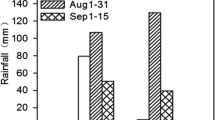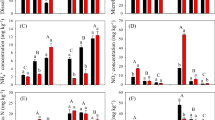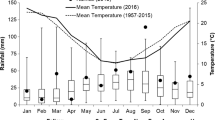Abstract
Fertilizer N losses on waterlogged texture-contrast soils (sand over clay) are usually attributed to denitrification and leaching. In this experiment, waterlogging events were imposed on 25-cm-diameter, 75-cm-long columns of texture-contrast soil planted to wheat (Triticum aestivum L.). Treatments included 6, 12, and 18 d of aerobic conditions between fertilization using 15N-labelled urea (5.0 g m-2) and 3-d waterlogging events. Denitrification, measured by 15N-chamber methods, was the largest loss mechanism identified during waterlogging. Dinitrogen was the main product of denitrification. Longer aerobic periods prior to waterlogging increased denitrification losses from 3.1 to 9.4% of the urea-N added. Leaching losses of 15NO3 (3.1 – 5.3%) between 20 and 70 cm were less than denitrification fluxes. Total15 N recovery in the wheat plants and soil was 87.9% before waterlogging and decreased to 72.3% after waterlogging. The balance of added fertilizer N was reasonably well reconstructed if it is assumed that NH3 volatilization accounted for the early loss of 12% of the urea-N, and that in addition to the measured surface fluxes of N2 + N2O, some of these gases remained entrapped in the soil. This study confirms that texture-contrast soils cropped to wheat have a high potential for N losses through denitrification and leaching during waterlogging events.
Similar content being viewed by others
References
Belford RK (1981) Response of winter wheat to prolonged waterlogging under outdoor conditions. J Agric Sci (Camb) 97: 557–568
Bronson KF Touchton JT Hauck RD and Kelley KR (1991) Nitrogen–15 recovery in winter wheat as affected by application timing and dicyandiamide. Soil Sci Soc Am J 55: 130–135
Bronson KF Mosier AR and Bishnoi SR (1992) Nitrous oxide emissions in irrigated corn as affected by nitrification inhibitors. Soil Sci Soc Am J 56: 161–165
Brooks PD Stark JM McInteer BB and Preston T (1989) Diffusion methods to prepare soil extracts for automated nitrogen–15 analysis. Soil Sci Soc Am J 53: 1707–1711
Burford JR and Bremner JM(1975) Relationships between the denitrification capacities of soils and total, water soluble and readily decomposable soil organic matter. Soil Biol Biochem 7: 389–394
Buresh RJ and Austin ER (1988) Direct measurement of dinitrogen and nitrous oxide in flooded rice fields. Soil Sci Soc Am J 52: 681–688
Cannel RQ Belford RK Gales K Dennis CW and Prew RD (1980) Effects of waterlogging at different stages of development on the growth and yield of winter wheat. J Sci Food Agric 31: 117–132
Crutzen PJ (1976) Upper limits on atmospheric ozone reductions following increased application of fixed nitrogen to the soil. Geophys Res Lett 3: 169–172
Fillery IRP and McInnes KJ (1992) Components of the fertiliser nitrogen balance for wheat production on duplex soils. Aust J. Exp Agric 32: 887–899
Fillery IRP and McInnes KJ (1997). Fate of 15N–labelled fertilisers applied to a deep sand and duplex soils in Western Australia. Aust J. Agric Res (In Press)
Firestone M.K. 1982. Biological denitrification. p. 289–326. InF.J. Stevenson (ed.). Nitrogen in Agricultural Soils. American Society of Agronomy, Madison, WI
Freney JR Smith CJ Mosier AR (1992). Effect of a new nitrification inhibitor (wax coated calcium carbide) on transformations and recovery of fertilizer nitrogen by irrigated wheat. Fert Res 32: 1–11
Hauck RD and Bremner JM (1976) Use of tracers for soil and fertilizer nitrogen research. Adv Agron 28: 219–261
Hingston FJ (1974) Seasonal distribution of mineral nitrogen with particular reference to leaching. Aust J Exp Agric Animal Husb 14: 815–821
IPCC–Intergovernmental Panel on Climate Change. 1990. Climate Change. The IPCC scientific assessment. Cambridge University Press
Jenkinson DS Fox RH and Rayner JH (1985) Interactions between fertilizer and soil nitrogen–the so–called “priming” effect. J Soil Sci 36: 425–444
Katyal JC Singh B Vlek PLG Buresh RJ (1987). Efficient nitrogen use as affected by urea application and irrigation sequence. Soil Sci Soc Am J 51: 366–370
Lindau CW Patrick Jr WH Delaune RD and Reddy KR (1990). Rate of accumulation and emission of N2, N2O and CH4 from a flooded rice soil. Plant Soil 129: 269–276
Meyer WS and Barrs HD(1988) Response of wheat to a single, short–term waterlogging during and after stem elongation. Aust J Agic Res 36: 171–185
McCarty GW and JM Bremner (1992) Availability of organic carbon for denitrification in subsoils. Biol Fertil Soils 14: 219– 222
McGarity JW (1961) Denitrification studies on some South Australian soils. Plant Soil 14: 1–21
Mosier AR and Mack L (1980) Gas chromatographic system for precise, rapid analysis of N2O. Soil Sci Soc Am J 44: 1121–1123
Mosier AR Guenzi WD and Schweizer EE (1986) Soil losses of dinitrogen and nitrous oxide from irrigated crops in Northeastern Colorado. Soil Sci Soc Am J 50: 344–348
Mosier AR Mohanty SK Bhadrachalam A and Chakravorti SP (1990) Evolution of dinitrogen and nitrous oxide from the soil to the atmosphere through rice plants. Biol Fertil Soils 9: 61–67
Mosier AR and GL Hutchinson (1981) Nitrous oxide emissions from cropped fields. J Environ Qual 10: 169–173
Olson RV (1987) Effects of field fertilizer practices on labeled ammonium–nitrogen transformations and its utilization bywinter wheat. Plant Soil 97: 189–200
Prade K Trolldenier (1990) Denitrification in the rhizosphere of plants with inherently different aerenchyma formation: Wheat (Triticum aestivum) and rice (Oryza sativa). Biol Fertil Soils 9: 215–219
Rodhe H (1990) A comparison of the contribution of various gases to the greenhouse effect. Science (WashingtonD.C.) 248: 1217–1219
Samson MI Buresh RJ and De Datta SK (1990) Evolution and soil entrapment of nitrogen gases formed in flooded soil. Soil Sci Plant Nutr 36: 299–307
Seigel RS Hauck RD and Kurtz LT (1982) Determination of 30N2 and application to measurement of N2 evolution during denitrification. Soil Sci Soc Am J 46: 68–74
Smith CJ Whitfield DM Gyles OA and Wright GC (1989) Nitrogen fertilizer balance of irrigated wheat grown on a red–brown earth in southeastern Australia. Field Crops Res 21: 265–275
Technicon (1973) Ammonia in water and waste water. Technicon Industrial method no. 98–70W, Technicon, Tarryton, New York.
Watson ER Lapins P and Barron RJW (1976) Effect of waterlogging on the growth, grain and straw yield of wheat, barley and oats. Aust J Exp Agric Anim Husb 16: 114–122
Webster CP Belford RK and Cannell RQ (1986) Crop uptake and leaching losses of 15N labeled fertilizer nitrogen in relation to waterlogging of clay and sandy loam soils. Plant Soil 92: 89–101
Weier KL Doran JW Power JF and Walters DT (1993) Denitrification and the dinitrogen/nitrous oxide ratio as affected by soil water, available carbon, and nitrate. Soil Sci Soc Am J 57: 66–72
Westerman RL and Kurtz LT (1974) Isotopic and non–isotopic estimations of fertilizer nitrogen uptake by sudangrass in field experiments. Soil Sci Soc Am J. 38: 107–109
Author information
Authors and Affiliations
Rights and permissions
About this article
Cite this article
Bronson, K., Fillery, I. Fate of nitrogen-15-labelled urea applied to wheat on a waterlogged texture-contrast soil. Nutrient Cycling in Agroecosystems 51, 175–183 (1998). https://doi.org/10.1023/A:1009725900571
Issue Date:
DOI: https://doi.org/10.1023/A:1009725900571




